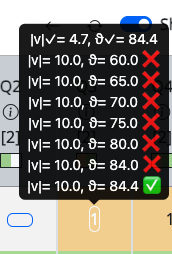Translations
| Code | Language | Translator | Run | |
|---|---|---|---|---|
 |
||||
Credits

 This email address is being protected from spambots. You need JavaScript enabled to view it.; leongster
This email address is being protected from spambots. You need JavaScript enabled to view it.; leongster
Pedagogical Simulation Games
Are you ready to embark on a wild adventure and explore the world of physics? Look no further than this simulation, found at https://iwant2study.org/lookangejss/02_newtonianmechanics_2kinematics/ejss_model_projectile_frog_2023/.
In this simulation, you play as a frog tasked with launching yourself through the air and land on the dragonfly. But don't be fooled, this is no ordinary game - it's a powerful tool for learning about projectile motion and kinematics.
With realistic physics simulations, you'll have the opportunity to experiment with variables such as launch angle and velocity, and see how they impact your trajectory. Not only will you gain a deeper understanding of these concepts, but you'll also have a blast in the process.
The simulation also includes helpful visual aids, such as motion diagram trails that display your path and speed over time. Plus, you can adjust the speed and launch angle to see how it affects your movement.
Whether you're a student looking to ace your physics class or simply a curious learner, this simulation is a fantastic resource for anyone interested in the mechanics of motion. So what are you waiting for? Launch yourself into this exciting world today!
Data Analytics
But that's not all - this simulation also includes data analytics that track your students' progress and help you identify areas where you need improvement. Every time you launch yourself, the simulation records whether you landed on the dragonfly correctly or not. If you land correctly on your first try, you earn two points. If you miss and then correct your trajectory, you earn one point.
This system of points is not only motivating, but it also encourages players to replay the simulation and improve their scores. Wit
h a total of 10 possible points, there's always room for improvement, and players are incentivized to keep trying until they've mastered the physics of projectile motion.
 |
| actual motion trails to help student remember their different angles of launch |
And the best part? The data analytics don't just benefit players - they're also a powerful tool for educators. Teachers can use the data to see which students are struggling with which concepts, and adjust their lessons accordingly. By analyzing patterns in the data, educators can gain a deeper understanding of how their students are learning and what areas need extra attention.
 |
| data analytics |
https://iwant2study.org/moodle402/mod/laejss/report_lti.php?title=Physics08+Projectile+Frog+Game&cm=69&cminstance=42&course=6&resourcelink=
Overall, this simulation is not just a fun and engaging game - it's a valuable resource for anyone looking to improve their understanding of physics. With realistic physics simulations, helpful visual aids, and a data analytics system that encourages replayability, this simulation is sure to be a hit with students and educators alike. So why not give it a try and see how many points you can score?
Need graphics but cant draw?
- Data Collection: To train the machine learning algorithm, you will need to collect a large dataset of images of frogs and dragonflies in different poses and environments. These images can be sourced from public databases or taken by photographers.
- Training the Algorithm: Once the dataset is collected, the machine learning algorithm is trained using deep learning techniques to recognize the features and characteristics of frogs and dragonflies. The algorithm learns to generate images of these creatures in different poses and environments.
- Generating the Images: After the algorithm is trained, you can input specific parameters such as the pose and environment you want the frog and dragonfly to be in, and the algorithm will generate a realistic image of the requested creature.
- Details
- Written by Loo Kang Wee
- Parent Category: 03 Motion & Forces
- Category: 01 Kinematics
- Hits: 4240


.png
)






